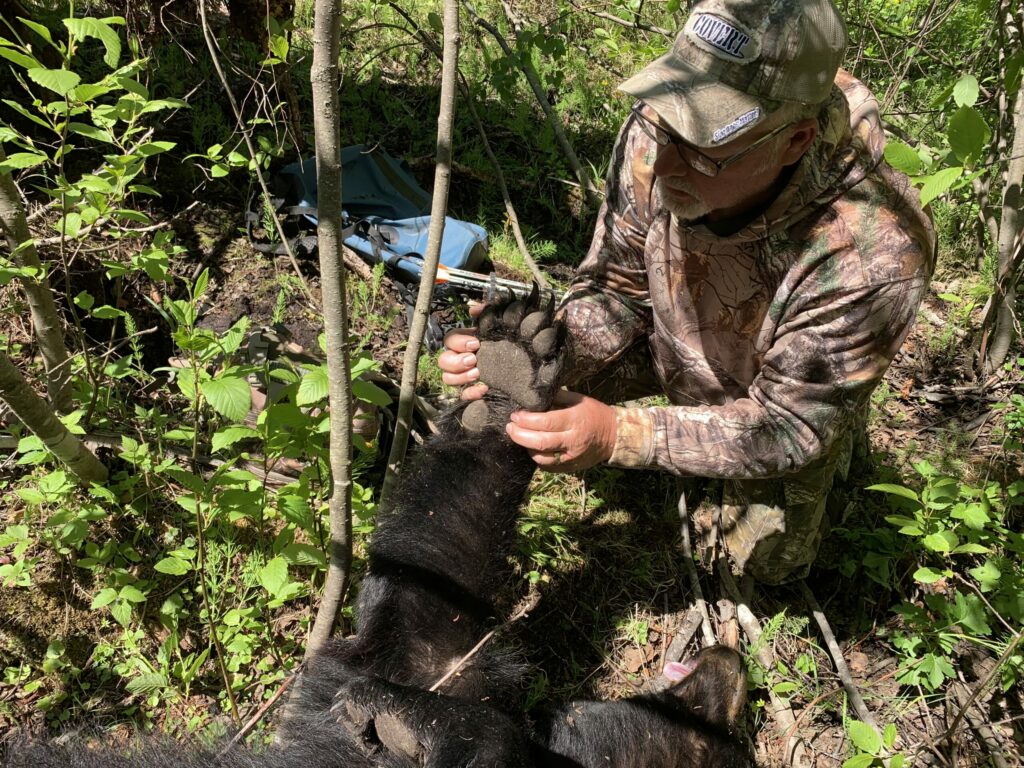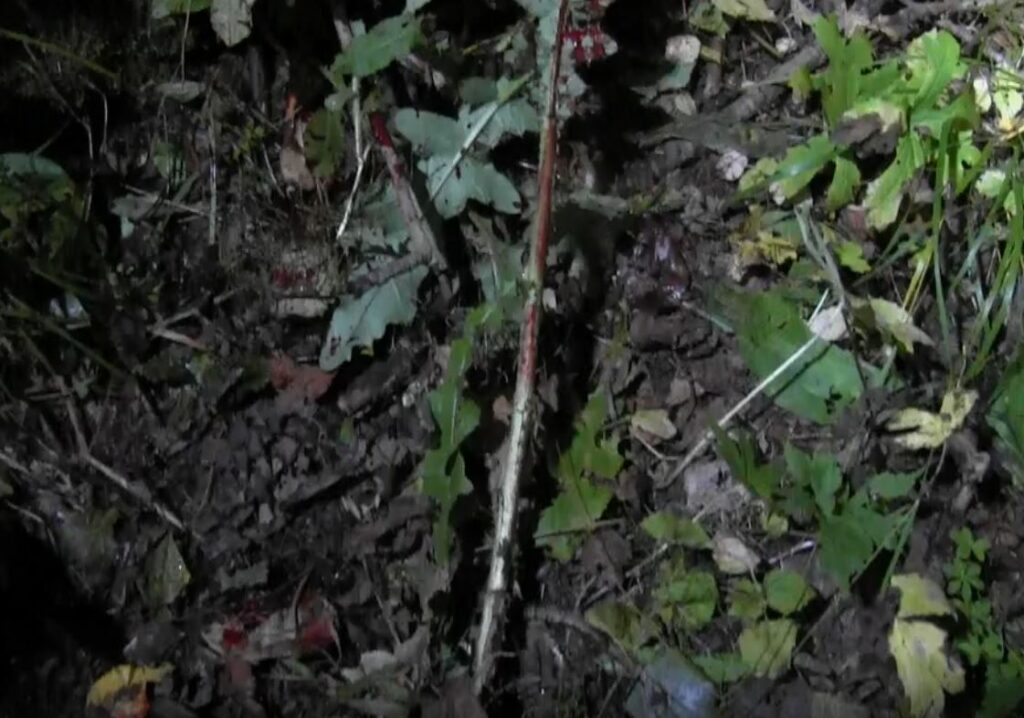Why it’s different than blood trailing deer
By Bernie Barringer
My 16-year-old daughter Crystal was sitting in a treestand just below me and to my left. I saw a black spot in the bush behind the bait and tried to tap her on the shoulder to warn her, but she was leaning forward, a 20-guage youth model shotgun loaded with slugs across her lap. I couldn’t reach her so I whispered “bear coming!” But when I looked back up, the black spot was gone.
Just 15 minutes later, the black spot was back and she saw it too. Another 15 minutes elapsed before a bear was standing at the bait, cautiously looking around. Eventually he turned broadside and Crystal calmly sent a slug though the heart of her first bear. It disappeared, but the noise of its running soon ceased. We got down and walked along the ample blood trail through the thick underbrush to the bear, making comments about the incredible amount of blood we were seeing. When we arrived, we were amazed to see that our pantlegs were soaked in blood from the knees down. A shotgun slug through the heart can really make a mess.

Finding a big bear after a long blood trail is a rewarding experience and well worth the effort it takes to get really good at tracking bears shot with an arrow
If only all blood trails were so easy. But they are not. Certainly, an arrow through the middle of the heart can create the same scenario, I’ve seen it myself. But like most bowhunters, you and I probably aren’t aiming for the heart, we are aiming for the sure thing of a double-lung shot.
There are a lot of variables that go into blood trailing bears, but here are some really critical ones: Was there an exit wound and was that exit wound low on the body? Is the arrow still in the bear? Did the bear run away or just walk away? Is the diaphragm punctured? Did you hear a death moan? These are all important clues that will help you as you follow a blood trail to a dead bear.
Most bears do not go far compared to deer. Shoot a buck through both lungs and he’ll run full speed until he falls over, usually about 150 yards. Shoot a bear through both lungs and he’ll probably run 30-40 yards before stopping to see what happened to him. He may die right there, or he may just start walking. Walking causes them to use less oxygen so they can live much longer than a bear which just runs until it gets light-headed and falls over.
I once shot a 500-pound bear which just walked away and kept walking. We followed a blood trail for more than 400 yards, and by that time I was convinced that I had misjudged where my shot hit the bear. But when we finally recovered the bear, it was exactly as I thought, I had punctured the diaphragm and clipped the back of the nearside lung, the front of the off-side lung and even nicked the heart. But because this bear did not require much oxygen on his 400-yard stroll, he was able to live a lot longer than a bear that would have run hard.
I love death moans, not because I like the eerie sound, but because it offers me two important facts that really help in recovery: I know the bear is dead, and I know the direction and approximate distance of the bear. I will still follow the blood trail to the bear in most every case because just walking up to the body of a dead bear in the thick bush is normally a lot harder than it sounds.

Bears tend to push leaves and plants over and aside where the blood from their fur “paints” the undersides of leaves
To digress a moment, someday I guess I should do a column on death moans and try to learn some scientific evidence for what causes them, but for now, I will tell you that I’ve killed 30 bears with a bow and I believe I have heard the death moan 8 or 9 times. At this point I cannot explain why some bears do it and some do not.
In addition to the 30 bears I have killed, I have been in on the recovery of about 50 more so I have followed a lot of blood trails. I can tell you this without flinching, if you have a low wound where the arrow exited the bear’s body, your chance of finding an easy to follow blood trail is probably 10 times better than if the arrow is still in the bear with no exit wound. I’ve said this before but it bears repeating: I’ll take two small holes in a bear over one big hole any time.
Keep this in mind when you are choosing your shot angles. I can think of two times when I executed a perfect double-lung shot on a bear which I was not able to recover, and both times it was because the arrow hit the off side leg bone or shoulder blade and did not exit.
Okay enough on that. Let’s assume you have blood trailed a few deer and compare what to look for in trailing a bear; much of which is quite a bit different than a deer. You’ve hit a bear and you’re on the blood trail; here’s what to look for.
A bear that’s shot through both lungs will have blood on both sides of the trail and also blood in the trail which is coming from the nose and mouth. Arrowed bears may not start out on an established bear trail, but any bear that still has his wits about him after about 15 seconds will be on a bear trail most every time. Here’s a really important image to keep in mind: When looking for blood on the sides, keep in mind that a bear’s fur is much like a paintbrush. As he walked through the brush, his body is moving aside the leaves and branches, and his fur is painting the undersides of the leaves as they are being brushed aside. This is an important source of information that many people miss.
That fur will also be painting the branches and stalks even if no blood is getting to the ground. Another place you will find this blood “painting” is when a bear crosses a downed log. I can think of a couple times I was able to find a bear even after the blood trail had ended; I circled the area, looking at every downed tree and log I could find and eventually found that the bear had doubled back, leaving a small streak of blood from his chest hair as he stepped over a log.
One drop of blood can lead to a bear, so don’t give up. I really prefer to trail with a partner who can stay at the last blood I found so I have a reference point. Too many cooks spoil the soup, and if there is a crowd, which there too often is, I ask them all to stay behind the person marking last blood. It’s also a good idea to mark the trail every so often to help you get a general line of travel, this is particularly true at night. Toilet paper works great for this because it is biodegradable. Please do not litter the woods with plastic flagging.
Be diligent in not getting too far away from last blood, move slowly and carefully and keep in mind that you’re not trailing a deer so you should be looking for different clues, and you’ll find your bear if it’s a dead bear. And if it’s not, go home and practice shooting until you have confidence that you can make a perfect double-lung shot at the next opportunity.

If you want to see how quickly a bear can expire after a well-placed video, check out this video on the Hunting Gear Deals youtube channel. https://youtu.be/D_yj-v0U_Hs?si=vCYLFDNlxPB22xmv